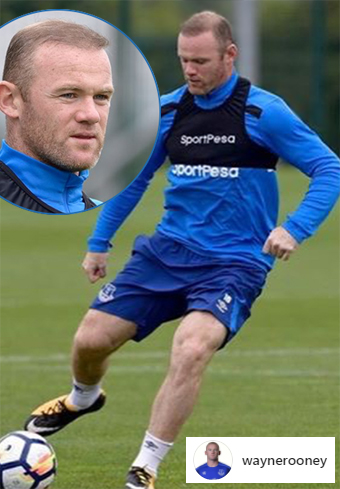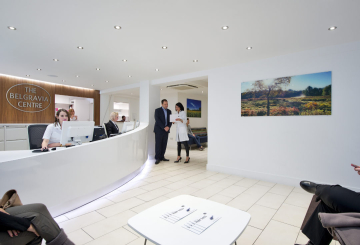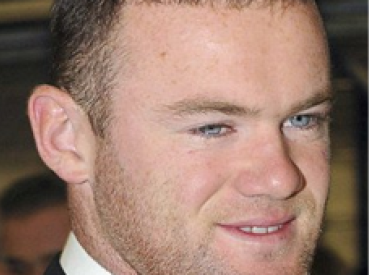Why Is Wayne Rooney Still Losing His Hair After Hair Transplants?
For men with the hair loss condition male pattern baldness, a hair transplant operation can sometimes seem like a tempting and very decisive way to deal with the issue. But as Everton star Wayne Rooney appears to be discovering, the results of hair restoration surgery may look good after the initial settling period, but may not look so great over time.
Rooney famously first had a hair transplant to deal with his thinning hair in 2011. He was applauded at the time for being one of the first footballer players of his generation to admit to it and even talk about it - something widely credited with helping dispel any secrecy or perceived stigma associated with men's hair loss. Since then, a number of other Premiership footballers have followed suit.
While Rooney’s first transplant initially appeared to have been a success, two years later Rooney was reportedly back at his surgeon’s to have more hair grafts to address his on-going issues which appear to include general thinning on top, as well as a receding hairline.
Now, the Daily Mirror suggests that Rooney’s apparently thinning hair remains something of a problem to the 32 year old, and that a third transplant may be in the wings.
So why has such a dedicated approach to dealing with his hairloss not worked out as well as it could? After all, hair transplants regularly cost more than £5,000 a time and there have even been reports that Rooney splashed out more than £30,000 trying to fix his hair.
To answer this, it is worth taking a moment to explain what exactly Rooney is trying to address. Male pattern baldness is an hereditary hair loss condition which affects the follicles located at the top of the head and frontal hairline. In these areas, the hair follicles have a different, increased susceptibility to a testosterone by-product named DHT. This hormone, which is used to develop sexual characteristics during puberty but is largely useless after this point, binds to the affected follicles in people with the relevant genetic predisposition. In doing so, over time it gradually weakens them during a process known as follicular miniaturisation, which shows outwardly as increasingly thinning hair and, in some cases, baldness.
The transplanted hairs should be immune to attack by DHT, but they can quickly form something of a ‘hair island’ if remedial steps are not taken to address the likely future shedding of the surrounding hairs.
The only clinically-proven way to do this is by using one or both of the only two clinically-proven male hair loss treatment products developed to inhibit the production of DHT and encourage new hairs to grow: finasteride 1mg and minoxidil. One explanation as to why Rooney’s hair is not all it could be is that he may not have been following a treatment course or, perhaps, his approach to one was somewhat half-hearted.
That isn’t to say that treatment courses are complex to follow; there are two potential MHRA licensed and FDA approved elements that medically-suitable men are typically recommended - the DHT blocking once-a-day tablet finasteride 1mg, and/or topical applications of high-strength minoxidil from the range of formulations this comes in.
Hair growth supporting products such as the FDA-cleared LaserComb do take a little more time to use, but are not all for daily use and they are optional additions. One additional hair growth product that certainly requires almost no effort is Hair Vitalics for Men, the food supplement designed exclusively by Belgravia hair experts. In addition to comprising premium quality, highly-targeted vitamins, minerals, amino acids and botanical extracts, including biotin, zinc and selenium for the maintenance of normal healthy hair growth, this convenient one-a-day tablet also includes saw palmetto. Click to View Success Stories for Belgravia Male Pattern Hair Loss Treatment Clients (Results May Vary and Are Not Guaranteed)
Click to View Success Stories for Belgravia Male Pattern Hair Loss Treatment Clients (Results May Vary and Are Not Guaranteed)
It is different for everybody, and all clients first need to get through the ‘stabilisation phase’ in which further hair shedding stops before regrowth can begin.
As with many men, there is little doubt that Wayne Rooney is seriously concerned about his hair. He first started losing his hair in his early 20s, which is becoming increasingly common. Many young men experiencing premature baldness find it can deal a significant blow to their confidence and self-esteem, so the way Rooney has been so open, speaking publicly about dealing with early onset balding, has been inspirational. His positive influence in busting long-standing taboos regarding men's hair loss and empowering those wanting to seek out solutions has even been nicknamed 'the Rooney Effect'.
Still though, his disappointment with his hair seems to linger, and there were even unsubstantiated reports last year that the player may have been using concealer products to give the impression of thicker hair during matches. These cosmetic products can be very tempting to those looking for a quick-fix for hair loss, and before/after pictures of these nanoparticle-based powders in action must be sorely tempting for many men.
Rather like hair pieces, however, they come with the potential for major stress in terms of worrying about how your hair looks at any given moment. They can also be time-consuming and do nothing to help with treating or preventing baldness, they simply mask how thin the hair has become.
The good news for Rooney is that his hair thinning does not appear to be so far gone that all hope is lost. If he were to try a bespoke treatment course for 6 to 12 months, he may be surprised by the results.
Rooney famously first had a hair transplant to deal with his thinning hair in 2011. He was applauded at the time for being one of the first footballer players of his generation to admit to it and even talk about it - something widely credited with helping dispel any secrecy or perceived stigma associated with men's hair loss. Since then, a number of other Premiership footballers have followed suit.
 Initial success short-lived
Initial success short-lived
While Rooney’s first transplant initially appeared to have been a success, two years later Rooney was reportedly back at his surgeon’s to have more hair grafts to address his on-going issues which appear to include general thinning on top, as well as a receding hairline.Now, the Daily Mirror suggests that Rooney’s apparently thinning hair remains something of a problem to the 32 year old, and that a third transplant may be in the wings.
So why has such a dedicated approach to dealing with his hairloss not worked out as well as it could? After all, hair transplants regularly cost more than £5,000 a time and there have even been reports that Rooney splashed out more than £30,000 trying to fix his hair.
To answer this, it is worth taking a moment to explain what exactly Rooney is trying to address. Male pattern baldness is an hereditary hair loss condition which affects the follicles located at the top of the head and frontal hairline. In these areas, the hair follicles have a different, increased susceptibility to a testosterone by-product named DHT. This hormone, which is used to develop sexual characteristics during puberty but is largely useless after this point, binds to the affected follicles in people with the relevant genetic predisposition. In doing so, over time it gradually weakens them during a process known as follicular miniaturisation, which shows outwardly as increasingly thinning hair and, in some cases, baldness.
The transplanted hairs should be immune to attack by DHT, but they can quickly form something of a ‘hair island’ if remedial steps are not taken to address the likely future shedding of the surrounding hairs.
The only clinically-proven way to do this is by using one or both of the only two clinically-proven male hair loss treatment products developed to inhibit the production of DHT and encourage new hairs to grow: finasteride 1mg and minoxidil. One explanation as to why Rooney’s hair is not all it could be is that he may not have been following a treatment course or, perhaps, his approach to one was somewhat half-hearted.
That isn’t to say that treatment courses are complex to follow; there are two potential MHRA licensed and FDA approved elements that medically-suitable men are typically recommended - the DHT blocking once-a-day tablet finasteride 1mg, and/or topical applications of high-strength minoxidil from the range of formulations this comes in.
Hair growth supporting products such as the FDA-cleared LaserComb do take a little more time to use, but are not all for daily use and they are optional additions. One additional hair growth product that certainly requires almost no effort is Hair Vitalics for Men, the food supplement designed exclusively by Belgravia hair experts. In addition to comprising premium quality, highly-targeted vitamins, minerals, amino acids and botanical extracts, including biotin, zinc and selenium for the maintenance of normal healthy hair growth, this convenient one-a-day tablet also includes saw palmetto.
Patience and consistency is key
Signing up for a hair loss treatment regime does require some commitment, however, and a key attribute is patience because new hairs don’t spring up overnight. While some clients may witness noticeable changes in three months, for others it may be five or six - sometimes more depending on factors such as how advanced the hairloss was when treatment first started.It is different for everybody, and all clients first need to get through the ‘stabilisation phase’ in which further hair shedding stops before regrowth can begin.
As with many men, there is little doubt that Wayne Rooney is seriously concerned about his hair. He first started losing his hair in his early 20s, which is becoming increasingly common. Many young men experiencing premature baldness find it can deal a significant blow to their confidence and self-esteem, so the way Rooney has been so open, speaking publicly about dealing with early onset balding, has been inspirational. His positive influence in busting long-standing taboos regarding men's hair loss and empowering those wanting to seek out solutions has even been nicknamed 'the Rooney Effect'.
Still though, his disappointment with his hair seems to linger, and there were even unsubstantiated reports last year that the player may have been using concealer products to give the impression of thicker hair during matches. These cosmetic products can be very tempting to those looking for a quick-fix for hair loss, and before/after pictures of these nanoparticle-based powders in action must be sorely tempting for many men.
Rather like hair pieces, however, they come with the potential for major stress in terms of worrying about how your hair looks at any given moment. They can also be time-consuming and do nothing to help with treating or preventing baldness, they simply mask how thin the hair has become.
The good news for Rooney is that his hair thinning does not appear to be so far gone that all hope is lost. If he were to try a bespoke treatment course for 6 to 12 months, he may be surprised by the results.

The Belgravia Centre
The Belgravia Centre is a world-renowned group of a hair loss clinic in Central London, UK. If you are worried about hair loss you can arrange a free consultation with a hair loss expert or complete our Online Consultation from anywhere in the world for home-use treatment.
View our Hair Loss Success Stories, which includes the world's largest gallery of hair growth photos and demonstrates the level of success that so many of Belgravia's patients achieve.

